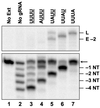Role of uridylate-specific exoribonuclease activity in Trypanosoma brucei RNA editing
- PMID: 12455977
- PMCID: PMC118049
- DOI: 10.1128/EC.1.1.112-118.2002
Role of uridylate-specific exoribonuclease activity in Trypanosoma brucei RNA editing
Abstract
Editing of mitochondrial mRNAs in kinetoplastid protozoa occurs by a series of enzymatic steps that insert and delete uridylates (U's) as specified by guide RNAs (gRNAs). The characteristics of the 3' exonuclease activity that removes the U's following cleavage during deletion editing were determined by using an in vitro precleaved deletion assay that is based on ATPase subunit 6 pre-mRNA and gA6[14] gRNA. The exonuclease in partially purified editing complexes is specific for U's. The specificity occurs in the absence of gRNA, but its activity is enhanced by the presence of gRNA. The 3' pre-mRNA fragment enhances the specificity, but not the efficiency, of U removal. The activity is sensitive to the 5' phosphate of the 3' fragment, which is not required for U removal. The ability of the 3' U's to base pair with purines in the gRNA protects them from removal, suggesting that the U-specific 3' exonuclease (exoUase) is specific for U's which are not base paired. ExoUase is stereospecific and cannot remove (Rp)alpha-thio-U. The specificity of the exoUase activity thus contributes to the precision of RNA editing.
Figures





Similar articles
-
RNA sequence and base pairing effects on insertion editing in Trypanosoma brucei.Mol Cell Biol. 2002 Mar;22(5):1567-76. doi: 10.1128/MCB.22.5.1567-1576.2002. Mol Cell Biol. 2002. PMID: 11839822 Free PMC article.
-
Uridylate addition and RNA ligation contribute to the specificity of kinetoplastid insertion RNA editing.Mol Cell Biol. 2000 Nov;20(22):8447-57. doi: 10.1128/MCB.20.22.8447-8457.2000. Mol Cell Biol. 2000. PMID: 11046141 Free PMC article.
-
RNA editing: a mechanism for gRNA-specified uridylate insertion into precursor mRNA.Science. 1996 Aug 30;273(5279):1189-95. doi: 10.1126/science.273.5279.1189. Science. 1996. PMID: 8703045
-
The genomic organization of guide RNA genes in kinetoplastid protozoa: several conundrums and their solutions.Mol Biochem Parasitol. 1997 Jun;86(2):133-41. doi: 10.1016/s0166-6851(97)00037-6. Mol Biochem Parasitol. 1997. PMID: 9200120 Review.
-
Dynamic RNA holo-editosomes with subcomplex variants: Insights into the control of trypanosome editing.Wiley Interdiscip Rev RNA. 2018 Nov;9(6):e1502. doi: 10.1002/wrna.1502. Epub 2018 Aug 12. Wiley Interdiscip Rev RNA. 2018. PMID: 30101566 Free PMC article. Review.
Cited by
-
Mutational analysis of Trypanosoma brucei editosome proteins KREPB4 and KREPB5 reveals domains critical for function.RNA. 2012 Oct;18(10):1897-909. doi: 10.1261/rna.035048.112. Epub 2012 Aug 23. RNA. 2012. PMID: 22919050 Free PMC article.
-
Dyskinetoplastic Trypanosoma brucei contains functional editing complexes.Eukaryot Cell. 2003 Jun;2(3):569-77. doi: 10.1128/EC.2.3.569-577.2003. Eukaryot Cell. 2003. PMID: 12796302 Free PMC article.
-
Pilot-Scale Screening of Clinically Approved Drugs to Identify Uridine Insertion/Deletion RNA Editing Inhibitors in Trypanosoma brucei.ACS Infect Dis. 2024 Sep 13;10(9):3289-3303. doi: 10.1021/acsinfecdis.4c00394. Epub 2024 Aug 9. ACS Infect Dis. 2024. PMID: 39118542
-
Complete cycles of bloodstream trypanosome RNA editing in vitro.RNA. 2004 Jun;10(6):914-20. doi: 10.1261/rna.5157704. RNA. 2004. PMID: 15146075 Free PMC article.
-
Uridine insertion/deletion RNA editing in trypanosome mitochondria: a complex business.RNA. 2003 Mar;9(3):265-76. doi: 10.1261/rna.2178403. RNA. 2003. PMID: 12591999 Free PMC article. Review.
References
-
- Aphasizhev, R., and L. Simpson. 2001. Isolation and characterization of a U-specific 3"-5" exonuclease from mitochondria of Leishmania tarentolae. J. Biol. Chem. 276:21280-21284. - PubMed
-
- Bhat, G. J., D. J. Koslowsky, J. E. Feagin, B. L. Smiley, and K. Stuart. 1990. An extensively edited mitochondrial transcript in kinetoplastids encodes a protein homologous to ATPase subunit 6. Cell 61:885-894. - PubMed
-
- Blum, B., N. Bakalara, and L. Simpson. 1990. A model for RNA editing in kinetoplastid mitochondria: “guide” RNA molecules transcribed from maxicircle DNA provide the edited information. Cell 60:189-198. - PubMed
Publication types
MeSH terms
Substances
Grants and funding
LinkOut - more resources
Full Text Sources

